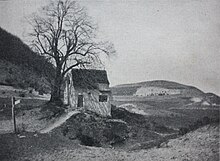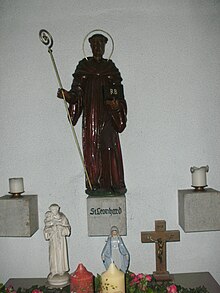Reiterleskapelle
The Reiterleskapelle (also Reiterles chapel or Reiterles Chapel , rare St. Leonhard chapel , formerly Reuterleskapelle ) is the holy Leonhard consecrated chapel on the pass between Rechbergle ( Black Horn ) and Graneggle on the Swabian Alb . The chapel above the hamlet of Tannweiler is a striking landmark of the community of Waldstetten and is a popular excursion destination.
Geographical location
The chapel is located south of Tannweiler and approx. 2 km east of Wißgoldingen at an altitude of 642 m. It stands on a mountain saddle between the 691 m high Rechbergle and the Graneggle , a foothill of the 781 m high Kalten Feld , and together with the summer lime tree next to it forms a striking boundary between the Christental and the valley that descends to Weilerstoffel and Waldstetten.
A few meters south of the Reiterleskapelle runs the border between the Ostalbkreis and the district of Göppingen .
history
According to the date carved into the lintel, the chapel is believed to be built in 1714. The estimated age of the linden tree next to the chapel as well as the legend of its origin (for both see below) suggest that the chapel was built earlier in the first half of the 17th century. It is not certain that the farmer, who lived at the so-called “Reiterleshof” ( “the farmer's Reuterle Hof” ) in Tannweiler, had the chapel built. The chapel is dedicated to St. Leonhard as the patron saint of farmers and livestock, especially horses. Nothing certain is known about the motivation and the history of the building. The then Gmünd city archivist Albert Deibele commented on the creation of the chapel:
“You don't know him. The year 1714 above the doorway allows only a few conclusions. It is probably a simple farmer from nearby Tannweiler; because the 'Reuterles' still live there today. […] Certainly, the building and the image were created with little skill, but with a lot of love and faith and a fine empathy for the landscape. "
The chapel is said to have belonged to the neighboring Christentalhof for a short time as a result of an inheritance .
There are various explanations for the origin of the name. One reads, “ the name Reiterleskapelle may come from Leonhardsritt or from the fact that the chapel as a Reiterle in the saddle between Rechbergle u. Graneggle lies. “The thesis of transferring the official name of the founder, Reiter or Reuter - in the latter case through a sound shift - to the band was refuted in the mid-1990s. Another explanation is the transfer of the house name of the farmer of the "Reiterleshof" to the chapel or a connection with the legend of the "wild rider Roth".
During the earthquake in the Swabian Alb on November 16, 1911, the masonry of the small chapel was severely damaged. However, in contemporary publications, the damage was also attributed to the linden tree's roots. From 1912 it was repaired by the Swabian Alb Association in cooperation with the Gmünder District Committee for Nature Conservation and Homeland Protection with the help of donations. A thorough renovation had to take place in 1957 after the chapel was in acute danger of collapsing. The interior was designed according to the ideas of post-war sacred architecture. Another renovation took place in 2014.
From autumn 1933 field services of the Schoenstatt Movement took place near the linden tree. In addition, the picture of the " Mother Thrice Admirable " was regularly brought to the top of the pass. In 1934 the Schoenstatt Movement also put the MTA sign on the front of the chapel.
The blessing of the horses on Ascension Day now held in front of the St. Patrick's Chapel in Weilerstoffel originally took place in front of the Reiterleskapelle.
In the run-up to the 300th anniversary, the community of Waldstetten, which had taken over the chapel from the district of Schwäbisch Gmünd during the district reform in 1973 , announced in September 2013 that the interior of the chapel would be redesigned in cooperation with the Baden-Württemberg State Monuments Office . On September 19, 2013, a group of friends was founded for the band.
Linden tree
The age of the summer linden tree by the Reiterleskapelle was determined around 1954 according to forestry estimates at 350 years. It is around a hundred years older than today's chapel. It is likely to have been planted around 1600 to serve as a signpost ("Zeiglinde") to the Christental Pass at this striking point.
In 1945 the linden tree was to be felled and the wood was to serve as an anti-tank barrier on the pass. This could be prevented through the intervention of a local farmer.
It is designated as a special natural monument in the area of the Cold Field.
Building description

The south gable of the chapel is optically supported by the linden tree, while the choir is north. As a result, the roof ridge is perpendicular to the crest of the bump.
The small, purpose-built chapel in the prayer room and choir is made of limestone from the surrounding White Jura , with a run -up to the higher northeast corner due to the terrain .
Both inside and out, the masonry is bribed , scraped and chiselled. The year 1714 is written above the entrance door. The two windows form a niche that expands the space from the inside . The interior of the chapel has a floor area of twelve square meters.
The roof is 52 ° pitch, rafter roof of grown wood. The weather vane on the roof ridge shows a rider who is popularly associated with the legend.
On the front side is the cast iron MTA symbol of the Schoenstatt Movement, on the east facade there is a recessed Mount of Olives group made up of figures .
Furnishing
The interior is kept simple. In the center is a statue of the patron saint of the chapel, Saint Leonhard of Limoges , among other things the patron saint of horses. The statue is flanked by various small figures of saints and a crucifix on a simple altar without any further decoration. There is a standing Madonna in a side niche .
In 1988 the baroque saints of St. John , St. Antonius and St. Georgius were stolen from the chapel . Thereupon the small chancel was barred.
On the walls, two panels deal with the history and legend of the Reiterleskapelle.
Legend of the Reiterleskapelle
After the funeral of Captain Joachim Berchtold von Roth († February 20, 1621) from Winzingen , the wealthy farmer Reuterle was late at night on his way home from the funeral when shortly before Tannweiler Roth suddenly rushed past him on a headless horse, accompanied by a great pack of headless dogs. Reuterle, deeply shocked, greeted the ghost, whom he had known well in his lifetime and had often helped out of financial embarrassment. He then roared: “ If I didn't know you, I'll tear you to tinder and shreds. "Then the spirits crowd stormed through the Heldenberg on and Reuterle fell into unconsciousness . When he awoke again at dawn, he prayed and, to the sound of the church bells in Wißgoldingen, vowed to build a chapel for the peace of mind of Baron von Roth.
Others
The chapel stands at the intersection of several hiking trails of the Swabian Alb Association . The Reiterleskapelle is also a stop on the regional hiking trail Glaubenswege, which was set up in 2003, and the Jakobsweg Göppingen , which opened in 2008 and for which a stamp office was set up in the chapel in August 2013.
A stage of the Albmarathon , a 50 km ultra marathon , also leads past the chapel.
literature
- Georg Stütz: " Homeland and hiking book for the Gmünder area ", self-published, Schwäbisch Gmünd 1919.
- Werner Lipp: Reiterleskapelle - "REUTERLES KÄPPELE" , typewritten manuscript, 1943, p. 12 (signature in the district archive of the LKR Göppingen: No. 4828).
- Werner Lipp: " Reiterles Kapelle ", in Schwäbische Heimat No. 6, December 1954, pp. 266–268.
- Anton Buck: Large Waldstetter Ortschronik in 6 volumes, typewritten, Waldstetten 1977, pp. 730–733. (Only a few copies published, one accessible in the Schwäbisch Gmünd city archive).
- Hans-Wolfgang Bächle : " Culture and history in the Gmünder area ", Remsdruckerei Sigg, Härtel & Co., Schwäbisch Gmünd 1982.
- Angelika Rieth-Hetzel: “ Zeitzeichen. History and stories from Waldstetten, Wißgoldingen ”, Waldstetten 1991.
- Florian H. Set: Mysterious Christian Valley. History and legend about the Granegg castle ruins and Reiterles chapel . 2nd revised edition, Messelstein-Verlag, Donzdorf 1995, ISBN 3-928418-10-6 , pp. 150-187.
- Bernardin Schellenberger: This is how our ancestors lived - The history of Winzingen and the surrounding area , Chronikkunst-Verlag Grob, Donzdorf-Winzingen 1995, pp. 73–129. (Fundamental to the historical facts of the legend of the "wild rider Roth").
- Collective of authors: “ Paths of Faith. Ways for the spirit, the soul; for hiking and enjoying ”, Verlag der Remsdruckerei, Schwäbisch Gmünd 2004, ISBN 3-926043-19-9 .
- Angelika Rieth-Hetzel: symbol of a modern church. The MTA sign on the Reiterles Chapel goes back to the Schoenstatt Movement. ( Memento from September 25, 2011 in the Internet Archive ) in Gmünder Tagespost from September 22, 2011.
Web links
- Homepage of the Reiterleskapelle (under construction)
Individual evidence
- ↑ Quotation from " About the origins of the Reiterles Chapel " in einhorn. Illustrated magazine for cultivating the idea of home in the town and district of Schwäbisch Gmünd , No. 23, einhorn-Verlag Eduard Dietenberger, Schwäbisch Gmünd, 1957.
- ↑ Werner Lipp: Reiterleskapelle - "REUTERLES KÄPPELE" , typewritten manuscript, 1943, p. 12 (signature in the district archive of the LKR Göppingen: No. 4828).
- ↑ Schneider, city building, Schwäb. Gmuend. Quoted in: Werner Lipp: Reiterleskapelle - "REUTERLES KÄPPELE" , typewritten manuscript, 1943, p. 12 (signature in the district archive of the LKR Göppingen: No. 4828).
- ↑ Florian H. Set: Mysterious Christental - History and legend about the Granegg castle ruins and Reiterles chapel , 2nd revised edition, Donzdorf 1995, ISBN 3-928418-10-6 , pp. 183-184.
- ↑ Florian H. Set: Mysterious Christental - History and legend about the Granegg castle ruins and Reiterles Chapel , 2nd revised edition, Donzdorf 1995, pp. 183-184.
- ↑ Bernardin Schellenberger: This is how our ancestors lived - The story of Winzingen and the surrounding area , Donzdorf-Winzingen 1995, pp. 73–129.
- ↑ Frey, Donzdorf : “ 6. The Reiterles Chapel between Kaltem Feld and Rechbergle ” in the article “ On the earthquake and its consequences ”; Leaves of the Schwäb. Albvereins , Volume XXIV, No. 2 (1912), p. 57f.
- ↑ a b Reiterleskapelle: Idyll with losses in the Rems newspaper, September 4, 2013; Retrieved September 5, 2013.
- ^ Special publication " 300 Years of the Reiterles Chapel ". In: Rems-Zeitung No. 235 of October 11, 2014, p. 31.
- ↑ Anna-Maria Schwarz: “ Horse blessing in Weilerstoffel with Pastor Bruno Hofmann. People must be there for the mount ”in Gmünder Tagespost from June 2, 2003.
- ↑ Werner Lipp: Reiterles chapel . In: Schwäbische Heimat No. 6, December 1954, p. 267.
- ^ German J. Krieglsteiner: " The cold field " in "Einhorn Jahrbuch Schwäbisch Gmünd 1975", Einhorn-Verlag Eduard Dietenberger KG, Schwäbisch Gmünd 1975.
- ↑ "Waldstetten: What does the Reiterleskapelle go back to?" , On www.swr.de.
- ↑ New stamp office for Jakobusweg pilgrims set up in the Reiterleskapelle in Waldstetten , in Rems-Zeitung of August 13, 2013; Retrieved August 14, 2013.
Coordinates: 48 ° 43 ′ 50.7 " N , 9 ° 50 ′ 16.3" E



